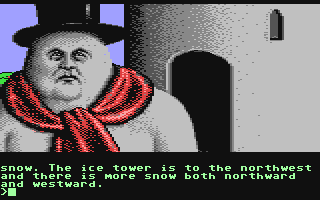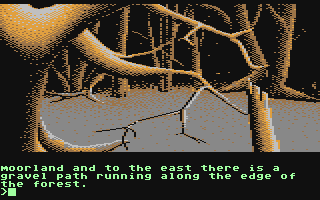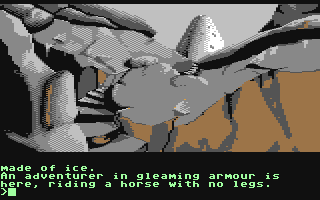|
Those of you who keep a beady aye on the general computer
press can already bear witness to the great success
this game has achieved on 16-bit micros. Now that The
Pawn has made a reappearance in the form of an 8
bit conversion, you can see just how well it has been
done.
The
name most associated with the game is Anita Sinclair,
a long time fan of Infocom who said she would only ever
write an adventure if she thought it was of at least
comparable quality. The Pawn was a result of
her efforts and its appearance on the Atari ST and Amiga
created a storm. Even the American market, notoriously
hard to break into and spoiled by the easy availability
of Infocom products, was impressed by this first effort
from Magnetic Scrolls.

After
having unwittingly become the game's central
character, this is the first view to greet your eyes.
Green and pleasant pastures meet Kilimanjaro.
The
game comes on two disks and is described as a text adventure
with some graphics as an 'extra'. This is what is known
as a gross understatement. The thirty or so graphic
screens accompanying the game were drawn by artist extraordinaire
Bob Stevenson, and are the best ever to appear on a
game of this type. The full screen graphics 'drop down'
over the text and succeed in adding to the atmosphere,
despite slowing the game down somewhat with each disk
access. Should this prove annoying, though, the pictures
can be turned off or put into a rather clever 'brief'
mode where they appear as miniature 'cameos' in the
top right-hand corner of the screen.
It
may be however, that you spend a couple of hours with
the packaging before you even bother to boot up the
game. The whole thing comes in a deep glossy A5 box,
complete with a novella, cypheric clues, a gameplay
guide, a poster and the two game disks. The production
value of the whole package is extremely high. The novella
is a lot of fun to read as well, dealing as it does
with the nefarious antics of members of the court of
Kerovnia and various characters with political and personal
ambitions . . .
And
this is where you come in. You have been grabbed out
of your normal world and plunged into Kerovnia in its
time of deepest trouble. From here on in, you're on
your own.

...
and looks what's waiting at the top. There's more
to this snowman than meets the eye.
The
first character you're likely to meet is the banished
wizard, Kronos. He gives you a note and asks for it
to be delivered to the king. This seems to be the quest
at first, but in fact, delivering the note is an easy
matter that only earns you a handful of points. After
that you're free to wander around and decide what you're
going to do.
During
your travels you will beet a variety of strange people
and circumstances, like the adventurer who rides a legless
horse; Honest John the trader, who is extremely difficult
to deal with; the sad uncommunicative snowman who guards
the entrance to the ice tower, and the mysterious guru
of the hills. Interaction with all of these characters
is refreshingly detailed, but will often cause headaches
when trying to figure out their cryptic clues. I would
avoid combat with them as well. They're all pretty tough.
While
you're wandering around, you may occasionally notice
a dotted red line across the ground. There is also a
series of accompanying notice boards explaining that
this marks the edge of the adventure and that no objects
may be taken beyond the line. Your character has a metal
wristband which, apparently, cannot be removed. As it
is an object, you are kept within the realms of Kerovnia.
A nice touch.

Eerie
forests have been the hallmark of many a
great adventure. This one hides more than one
secret behind the bark ...
Despite
the presence of several high quality graphic screens,
the location descriptions are exquisitely written and
are on a par with many Infocom and Level 9 games; in
fact, they are markedly superior in some cases. The
parser too, allows horrendously complex constructions
to be created by the player and the resulting freedom
of expression can try the game to its limits. Responses
are often tongue in cheek, but usually well thought
out, and the vocabulary is absolutely huge.
A
wax dummy like me rarely gets the chance to give a game
a Gold Medal and I was sorely tempted to do so with
The Pawn. Discretion prevailed, however, as even
a wondrous work such as this can be flawed. And indeed
it is. In certain locations it's possible to move in
a theoretically impossible loop. In one case, I tried
to move up whilst inside a room and was greeted with
the same piece of text I'd had when approaching the
location and told that I was outside the room. Another
time, a similar occurrence happened on a mountainside.
Most confusing. Also, some of the coded clues were physically
too long for the input buffer, resulting in one frustrated
wax dummy pulling at his wick!

Just
to prove we actually played it ... you can't simply
wander into stunning scenes like this you know!
Takes a bit of work with the old grey stuff ...
One
of the best features of the game is the hint section.
At the back of the novella there is a series of puzzles
with coded replies. Typing 'HINT' earns a response asking
for the particular code from the book. These codes are
horrendously long and yet, when typed, often turn out
to be no more than cryptic nudges in the right direction.
Worse still, a response may read: 'You need more points
to find that out' -- after you have spent five minutes
carefully inputting codes! Well, I guess it serves you
right for trying to cheat!
The
game also earns a plus point from its protection routine.
The game can actually be copied if the right instructions
are followed, but on restoring a saved game the computer
puts you to a little test that relies on the existence
of the novella, to ensure that you have a bona fide
copy of the game. Three chances are given before something
very nasty happens . . .
What
is difficult to remember is that this is the first game
from a new company. In parts it is a little inconsistent,
in others minor bugs may be lurking, waiting to pester
you. The game will be remembered as a classic, despite
its faults, and rightly so. The Pawn is one of
the best graphic adventures this year and will keep
you hunched over your beloved keyboards for ages. Don't
miss it.
|